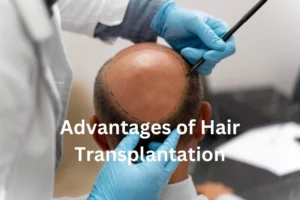Hair transplantation is a modern method to treat hair loss or baldness. Surgeons transplant hair just like they transplant other body parts, such as kidneys or eyes. They take hair from one part of the head and transplant it to another.
People refer to the front part of the head as the temporary zone. The hair in this area does not last permanently. It falls out over time due to aging, hereditary factors, hormonal changes, or physical complications.
Experts call the area at the back of the head and the sides near the ears the permanent zone. The hair in this region remains permanent. Surgeons refer to the part of the permanent zone where they remove hair or follicles as the donor area.
Hair Transplant Methods
Hair transplantation is a delicate surgery.
1. FUT (Follicular Unit Transplantation)
2. FUE (Follicular Unit Extraction)
3. DHI (Direct Hair Implantation)
How Hair Transplantation Is Done
FUT: In the FUT method, about half an inch of skin is cut from the back of the head. From there, the follicles are extracted and implanted at the front of the head. This method is relatively complicated.
FUE: In the FUT technique, approximately half an inch of the scalp is removed from the back of the head. Later, it is implanted in the front. This method does not require cutting.
DHI: DHI is the most advanced technique for hair transplantation. In this method, each hair is manually removed using a hand punch. It has fewer ccomplications
FUT: In the FUT method, surgeons cut about half an inch of skin from the back of the head. They extract the follicles from this strip and implant them at the front of the head. This method is relatively complex.
FUE: In the FUE method, surgeons remove individual hair follicles directly from the scalp, typically from the back of the head. They then implant these follicles in the front. This method does not involve cutting a strip of skin.
DHI: DHI is the most advanced technique for hair transplantation. Surgeons manually remove each hair follicle using a hand punch and implant it directly. This method has fewer complications
Who Can Undergo Hair Transplant
1. Those who suffer from hair loss due to hereditary or hormonal reasons before the age of 25–30.
2. Women whose hair falls out after menopause.
3. Those who lose their hair due to accidents where it is almost impossible for new hair to grow.
1. People who experience hair loss caused by hereditary or hormonal factors before the age of 25–30.
2. Women who lose hair after menopause.
3. Individuals who lose hair due to accidents that make new hair growth nearly impossible.
Advantages of Hair Transplant
1. The transplanted hair falls out after a few days and starts growing again. This hair begins to grow within four to six months, and the benefits of hair transplantation become visible within one to one and a half years.
2. No special care is required after a hair transplant, and follow-ups are not necessary.
3. There are no issues with cutting, rebonding, or curling the transplanted hair.
1. The transplanted hair sheds after a few days and then starts growing again. It begins to regrow within four to six months, and the results of the hair transplant become noticeable within one to one and a half years.
2. Patients do not need special care or follow-up appointments after a hair transplant.
3. People can cut, rebond, or curl the transplanted hair without any issues.
What is an FUE hair transplant?
FUE Hair transplant surgery is performed to address thinning and baldness in men. In most men, hair loss is caused by dihydrotestosterone (DHT), a hormone that causes hair to thin and eventually fall out. In those suffering from this condition, hair is initially lost at the temples and crown but can progress to the top of the scalp with age. Hair on the back and sides of the scalp is entirely resistant to this hair-loss process. When transplanted to other areas, these hairs can grow permanently. At The Treatment Rooms, surgeons carefully evaluate hair loss and collaborate with you to develop a personalized treatment plan to restore hair in balding areas. One preferred surgical method is follicular unit excision (FUE) hair transplant surgery. This method employs a circular surgical punch to extract each hair follicle individually by cutting around it and freeing the root from the surrounding tissue.
Finally,
each follicle is then lifted out with great care to protect it. Small cuts are created in the desired scalp area, carefully adjusted for hair depth, angle, direction, and density. Each hair is then implanted one by one. The procedure is conducted entirely under local anesthesia, enabling you to sit back and remain comfortable. The donor area, from which hairs have been removed, heals with dot-like scars less than a millimeter in diameter. Typically, these scars are not visible when the surrounding hair is trimmed to a grade one or two length. After one to three months, the newly implanted hairs will shed before growing again in four to twelve months. This is the point at which the complete hair transplant outcome becomes visible. The effects are expected to persist for more than 20 years and possibly for a lifetime.
